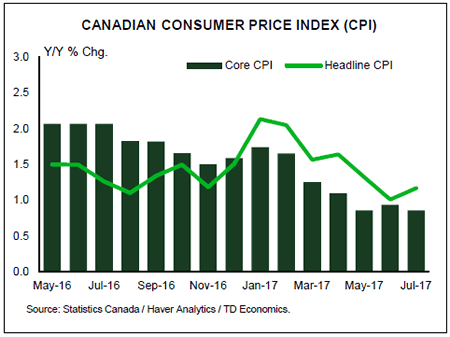U.S. Highlights
- Investors and analysts reading the economic tea leaves were given mixed messages this week. On the one hand, inflation ticked up, but on the other, consumer spending softened.
- Consumer prices rose 0.4% (m/m) in August, pushing inflation to 1.9% (y/y) from 1.7%. A sharp rise in gasoline prices on the back of refinery shutdowns contributed to the gain. Core prices accelerated to 0.2% (m/m).
- Retail sales, on the other hand, fell 0.2% in August. With downward revisions to June and July, momentum in consumer spending has slowed heading into the third quarter relative to its blistering pace in Q2.
Canadian Highlights
- Housing data for August was fairly positive, with starts trending higher and resale activity recovering slightly.
- Canadians continued to pile on debt in the second quarter, sending the household debt-to-disposable income ratio to a new high of 167.8%. Despite a slight uptick, household leverage ratios remain well below post-crisis highs, reflecting strong asset value gains over this time.
- Census data provides an interesting insight into the post-crisis evolution of Canadian incomes. Commodity-oriented provinces saw marked gains in median incomes, while much more modest growth was recorded elsewhere, reflecting the uneven impact of macroeconomic drivers over the 2010-2015 period.
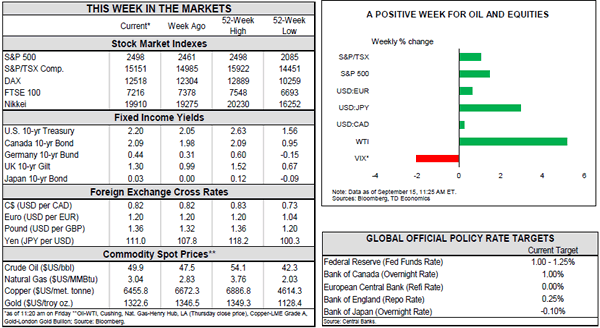
U.S. – The Data Giveth and the Data Taketh Away
Investors and analysts reading the economic tea leaves for signals on future Federal Reserve policy were given mixed messages this week. On the one hand, inflation ticked up, but on the other, consumer spending softened. Further muddying the water, both the CPI and retail sales reports were affected by Hurricane Harvey, a phenomenon that will continue in the months ahead.
One of the chief concerns of the Federal Reserve recently has been the persistent weakness in inflation. Despite ongoing improvement in the job market and an unemployment rate comfortably below target, price growth been slowing for much of this year. Inflation according to both the overall CPI and the core measure peaked in February. Energy prices contributed to inflation early in the year, but the impact was fleeting. Moreover, the weakness in inflation cannot be attributed entirely to idiosyncratic factors. Measures that strip them out, such as median and trimmed-mean inflation, have also decelerated noticeably.
One month does not a trend make, but August may be an early sign of a reversal in this downward trend. Headline consumer prices rose 0.4% on the month, pushing year-on-year inflation to 1.9% from 1.7%. A sharp rise in gasoline prices (6.3% month-over-month) on the back of refinery shutdowns due to Hurricane Harvey contributed to the gain in the headline.
More convincing was the gain in core prices and in the aforementioned median and trimmed mean measures. Core prices rose 0.2% on the month (0.249% to be precise), the strongest gain since January. While Harvey may have had some impact on core prices, the acceleration was broad-based with both median and trimmed-mean prices accelerating noticeably (both up 0.2%).
For the Federal Reserve, evidence that inflation may finally be heading higher should provide confidence that the economy is ready for higher interest rates. However, it will also want to see signs that the economic recovery remains on track. In that regard the pullback in retail sales (down 0.2% in August) provided a cautionary note As with the CPI data, Hurricane Harvey was likely an influence, especially for auto sales, which fell 1.6% in dollar terms (units fell 4%). Nonetheless, downward revisions to both June and July suggest less momentum in consumer spending even prior to Harvey. While spending is likely to rebound as the recovery efforts from Harvey and Irma take shape, a broader-based slowdown will not go unnoticed at the Fed.
All of this comes as the FOMC is due to meet to deliberate policy early next week. The Fed appears unlikely to hike its key lending rate at this meeting, but it is likely to announce plans to gradually begin unwinding its balance sheet. These have been well telegraphed to markets with most of the impact on bond yields already priced in. More important will be how much the statement recognizes the recent moves in inflation and how this comes through in the expectations of FOMC members for future policy rates, which will be released in the Survey of Economic Projections along with the policy statement. Stay tuned until Wednesday afternoon for more details.
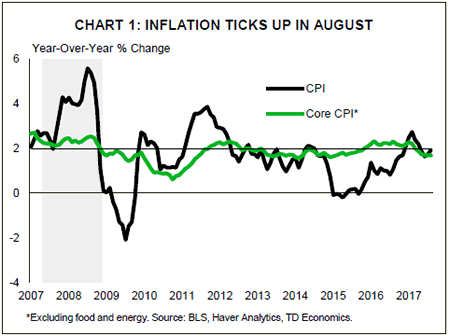
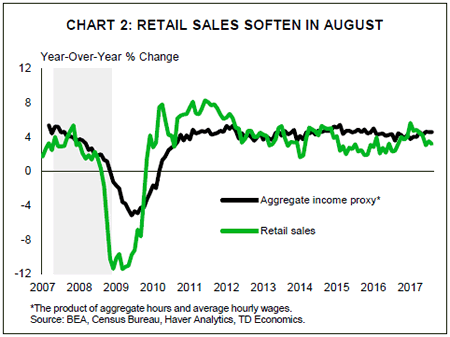
Canada – A Decent August for Housing
It was a mixed week in the markets, with the Canadian dollar back roughly near where it started the week as of writing, reflecting the offsetting impacts of rising oil prices (which touched $50/barrel on Thursday) and a more positive outlook for U.S. rates. Improved oil prices supported Canadian equities, which were up slightly as of mid-morning Friday.
Data this week was focused on housing and borrowing. To begin with, the resale housing market might have softened in Ontario, but housing starts rebounded in August, helping push the national trend higher (Chart 1). Once again, multi-family homebuilding led the way, likely driven by the pre-sale of projects in the year prior. Because of the prevalence of multi-unit projects (about 60% of total starts), housing starts provide more of a backwards-looking view of how the market is evolving. As such, we remain of the view that starts are likely to trend lower as the year progresses, consistent with the evolution of the Toronto market earlier this year. It is important to remember that despite all the attention Toronto receives, most other major markets are expected to see steady activity, keeping overall starts around 200k on a medium-term basis.
Indeed, the Toronto market is already showing signs of turning the corner, with data for August showing a 14.3% month-on-month increase in sales activity (although it remains well below earlier peaks), and a roughly balanced sales-to-listing ratio. It is clearly early days and there are many moving parts (not least of which are rising borrowing costs and potential changes to mortgage qualification rules for uninsured borrowers), but there is at least some scope for cautious optimism regarding the Greater Toronto Area housing market.
The rise in rates comes against a backdrop of further indebted Canadian households. Data for the second quarter showed a 1.2%-point increase in the ratio of debt-to-income, as household borrowing outpaced income growth. The debt service ratio remained flat as interest costs hit a record low 6.0% of income (covering the second quarter of the year, this data does not include the effects of the Bank of Canada’s back-to-back interest rate hikes). Although the debt-to-asset ratio ticked up slightly, indicating rising household leverage, it nevertheless remains well below post-crisis highs as the value of household assets grew more quickly than borrowing over this time.
Dialing the focus back a bit from the high frequency data, Census data released this week provides an interesting insight into the relative performance of the provinces over the post crisis period, in terms of median household income (Chart 2). The impact of the resource boom is clear, despite the Census data capturing the first year of the oil price downturn. Income growth was strongest in the commodity producing provinces of Saskatchewan, Newfoundland and Labrador, and Alberta. Conversely, its high starting point resulted in Ontario remaining near the top of the ranks, but Ontario saw the weakest income growth, likely a reflection of the challenges facing its industrial base over this period. If this data tells us anything, it serves as a clear reminder that beneath the aggregate data often lurk divergent outcomes among groups and regions.
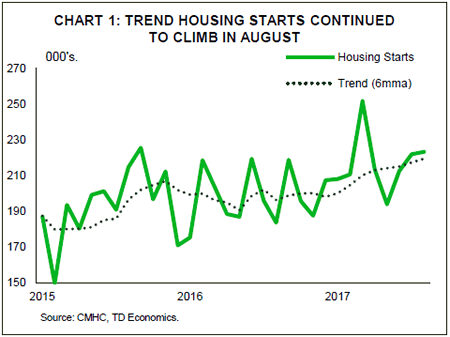
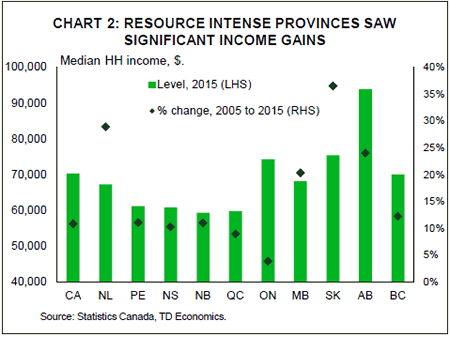
Canada: Upcoming Key Economic Releases
Canadian Manufacturing Sales – July
Release Date: September 19, 2017
Previous Result: -1.8% m/m
TD Forecast: -1.5% m/m
Consensus: -0.7% m/m
Canadian manufacturers’ summer doldrums are expected to continue into July with nominal sales forecast to decline a further 1.5% m/m. Much of this reflects the unruly appreciation in the Canadian dollar, which was the driving force behind a sharp decline in factory prices, though we do anticipate some pullback in real activity as well. Transportation shipments are expected to exert a sizeable drag after international trade data showed a significant pullback in exports of both motor vehicles and aircraft. We see scope for a pullback in machinery shipments, which are up over 20% on the year, after a sharp decline in export activity. We also see downside risks to forestry product shipments after a series of wildfires shuttered BC lumber mills for part of the month.
While the decline in real manufacturing sales should prove to be more modest than the nominal print, they are coming off a 1.0% decline in June so another negative print will be to the detriment of Q3. While our current tracking points towards GDP growth in the mid-2% range, this is due largely to the resilience of consumer spending and the outlook for exports is less upbeat.
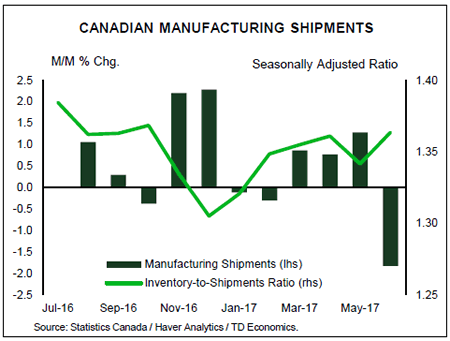
Canadian Retail Sales – July
Release Date: September 22, 2017
Previous Result: 0.1% m/m, ex-auto 0.7% m/m
TD Forecast: 0.1% m/m, ex-auto 0.3% m/m
Consensus: 0.3% m/m, ex-auto 0.5% m/m
Retail sales are forecast to rise by 0.1% m/m in July while weaker motor vehicle spending should leave the ex-autos measure up 0.3% on the month. Last month’s report showed that the slowdown in the Toronto housing market has weighed on big ticket purchases by local residents, and we expect this regional underperformance to continue into July. Outside of the Toronto region, labour market gains and elevated consumer confidence should continue to drive spending and sesquicentennial Canada Day celebrations could add to general merchandise and food and beverage sales. Meanwhile, the increase in consumer prices should see real retail sales underperform the nominal print. Given the solid handoff from June and a stabilization in the Toronto housing market, we think that household spending will remain one of the prominent drivers of growth in Q3 but expect PCE to moderate from the 4.6% advance in Q2.
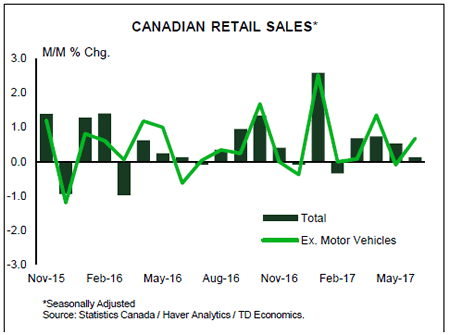
Canadian Consumer Price Index – August
Release Date: September 22, 2017
Previous Result: 0.0% m/m, 1.2% y/y
TD Forecast: 0.2% m/m, 1.5% y/y
Consensus: 0.2% m/m, 1.5% y/y
TD expects headline inflation to firm to 1.5% in August from 1.2%, reflecting a 0.2% monthly increase in consumer prices and favourable base effects. Gasoline prices should serve as a key source of inflationary pressure though some of this can be faded due Hurricane Harvey’s impact on refineries. Shelter prices should also provide a tailwind as new home prices have yet to adjust to the slowdown in the housing market. However, food prices are likely to offset the strength elsewhere due to the combination of falling agricultural prices and FX passthrough. We expect measures of core inflation to remain stable but the risks lean towards another modest improvement.
